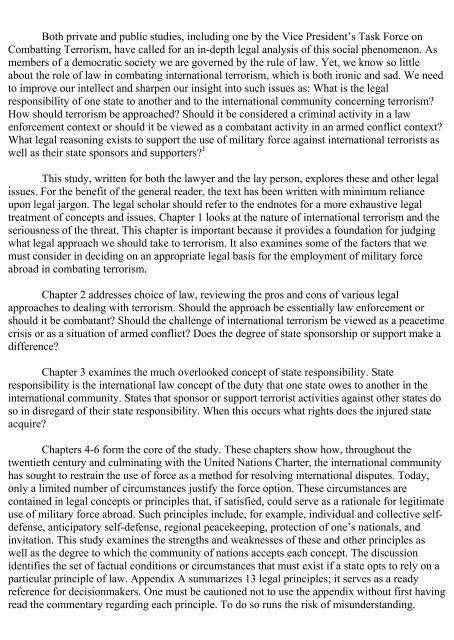Legitimate use of military force against state-sponsored - Air University
Legitimate use of military force against state-sponsored - Air University
Legitimate use of military force against state-sponsored - Air University
Create successful ePaper yourself
Turn your PDF publications into a flip-book with our unique Google optimized e-Paper software.
Both private and public studies, including one by the Vice President’s Task Force on<br />
Combatting Terrorism, have called for an in-depth legal analysis <strong>of</strong> this social phenomenon. As<br />
members <strong>of</strong> a democratic society we are governed by the rule <strong>of</strong> law. Yet, we know so little<br />
about the role <strong>of</strong> law in combating international terrorism, which is both ironic and sad. We need<br />
to improve our intellect and sharpen our insight into such issues as: What is the legal<br />
responsibility <strong>of</strong> one <strong>state</strong> to another and to the international community concerning terrorism?<br />
How should terrorism be approached? Should it be considered a criminal activity in a law<br />
en<strong>force</strong>ment context or should it be viewed as a combatant activity in an armed conflict context?<br />
What legal reasoning exists to support the <strong>use</strong> <strong>of</strong> <strong>military</strong> <strong>force</strong> <strong>against</strong> international terrorists as<br />
well as their <strong>state</strong> sponsors and supporters? 1<br />
This study, written for both the lawyer and the lay person, explores these and other legal<br />
issues. For the benefit <strong>of</strong> the general reader, the text has been written with minimum reliance<br />
upon legal jargon. The legal scholar should refer to the endnotes for a more exhaustive legal<br />
treatment <strong>of</strong> concepts and issues. Chapter 1 looks at the nature <strong>of</strong> international terrorism and the<br />
seriousness <strong>of</strong> the threat. This chapter is important beca<strong>use</strong> it provides a foundation for judging<br />
what legal approach we should take to terrorism. It also examines some <strong>of</strong> the factors that we<br />
must consider in deciding on an appropriate legal basis for the employment <strong>of</strong> <strong>military</strong> <strong>force</strong><br />
abroad in combating terrorism.<br />
Chapter 2 addresses choice <strong>of</strong> law, reviewing the pros and cons <strong>of</strong> various legal<br />
approaches to dealing with terrorism. Should the approach be essentially law en<strong>force</strong>ment or<br />
should it be combatant? Should the challenge <strong>of</strong> international terrorism be viewed as a peacetime<br />
crisis or as a situation <strong>of</strong> armed conflict? Does the degree <strong>of</strong> <strong>state</strong> sponsorship or support make a<br />
difference?<br />
Chapter 3 examines the much overlooked concept <strong>of</strong> <strong>state</strong> responsibility. State<br />
responsibility is the international law concept <strong>of</strong> the duty that one <strong>state</strong> owes to another in the<br />
international community. States that sponsor or support terrorist activities <strong>against</strong> other <strong>state</strong>s do<br />
so in disregard <strong>of</strong> their <strong>state</strong> responsibility. When this occurs what rights does the injured <strong>state</strong><br />
acquire?<br />
Chapters 4-6 form the core <strong>of</strong> the study. These chapters show how, throughout the<br />
twentieth century and culminating with the United Nations Charter, the international community<br />
has sought to restrain the <strong>use</strong> <strong>of</strong> <strong>force</strong> as a method for resolving international disputes. Today,<br />
only a limited number <strong>of</strong> circumstances justify the <strong>force</strong> option. These circumstances are<br />
contained in legal concepts or principles that, if satisfied, could serve as a rationale for legitimate<br />
<strong>use</strong> <strong>of</strong> <strong>military</strong> <strong>force</strong> abroad. Such principles include, for example, individual and collective selfdefense,<br />
anticipatory self-defense, regional peacekeeping, protection <strong>of</strong> one’s nationals, and<br />
invitation. This study examines the strengths and weaknesses <strong>of</strong> these and other principles as<br />
well as the degree to which the community <strong>of</strong> nations accepts each concept. The discussion<br />
identifies the set <strong>of</strong> factual conditions or circumstances that must exist if a <strong>state</strong> opts to rely on a<br />
particular principle <strong>of</strong> law. Appendix A summarizes 13 legal principles; it serves as a ready<br />
reference for decisionmakers. One must be cautioned not to <strong>use</strong> the appendix without first having<br />
read the commentary regarding each principle. To do so runs the risk <strong>of</strong> misunderstanding.
















